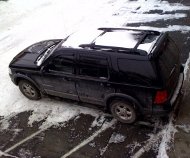2/18/2013
Montana Supreme Court OKs Stops For Snow On License PlateHigh court in Montana rules cops can stop motorists whenever snow blocks their license plate.

Police can stop and ticket motorists with a bit of snow on their license plate, according to a ruling Tuesday by the Montana Supreme Court. Mark Andrew Haldane had been stopped at a red light in his brand new SUV on 23rd Street in Bozeman on a chilly, sub-zero evening on January 12, 2011. Officer Hal Richardson was showing a trainee, Lindsay Shephard, the ropes, so when Haldane passed Officer Richardson decided to pull over Haldane's black Ford Explorer because its temporary license plate was obstructed by snow and a trailer hitch. The hitch alone was not a cause for the stop, as Officer Shephard testified she could not read the numbers when combined with the accumulated snow.
The plate was valid and the car came with the hitch, as Haldane had purchased the vehicle on January 10. Though it was not snowing when the stop took place two days later, the ground and roadway were covered in snow, which accumulated in the well directly in front of Haldane's temporary license. Haldane said he had no reason to believe his valid permit was obstructed. Since Montana bans the use of speed cameras and red light cameras and has no toll roads, there would be little advantage to doing so.
Once the officers were on foot, they could read the plate and were able to verify the information with their in-car computer system. In the course of the stop, however, Haldane was found to be intoxicated and was arrested for driving under the influence (DUI). Haldane appealed his sentence, insisting it is a Fourth Amendment violation to stop someone over a snowy license plate.
"This court cannot interpret Montana Code Sections 61-3-224(5) and -301 to allow for the seizure of a private citizen based on merely a partial obstruction, from a certain vantage point, by a factory-installed trailer ball hitch or a natural accumulation of snow," Haldane's public defender, Jennifer A. Hurley, argued. "Allowing an intrusion into privacy on such grounds, especially in Montana with our weather and prevalence of farm and other towing vehicles, violates our constitutional guarantee to be secure in our persons against unreasonable seizures."
Montana law requires plates be "conspicuously displayed" and "not obstructed from plain view." The high court found this sufficient to justify the traffic stop.
"The terms 'obviously visible' and 'plain view' certainly contemplate a higher standard of visibility than that the plate merely be decipherable upon close inspection by an officer who has exited his vehicle and stands over the bumper," Justice Patricia O. Cotter wrote for the court. "Haldane's interpretation of [the law] compels a hypertechnical reading of the statute and ignores its purpose... The investigatory stop was supported by particularized suspicion and the officers did not exceed the permissible scope of the investigatory stop."
The court unanimously upheld Haldane's conviction, but it ordered a new sentence after finding the district court went too far in imposing the maximum penalty.
A copy of the decision is available in a 160k PDF file at the source link below.


